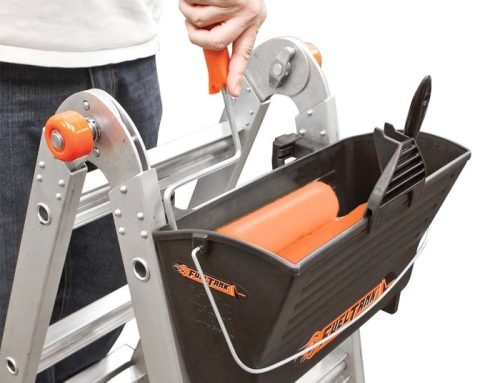Easter is the perfect time to run some ladder refresher training, because nothing motivates people quite like the promise of chocolate! While a domestic egg hunt for kids involves hiding chocolate at the eye level of a child, running one for adults gives you a lot more leeway in terms of hiding spots, especially when you involve ladders in the search.
Setting up
The safety aspect starts when you hide the Easter eggs – it’s not going to be much of a lesson if you end up in A&E before it even gets started! Select the main ladder styles that your staff use regularly, plus a couple that might be used infrequently and therefore aren’t as familiar.
An A-frame stepladder would be ideal, plus a freestanding step ladder (a combination ladder in this mode is ideal), perhaps to reach an Easter egg placed on a strip light? Think about how you can place eggs to encourage people to think about the most efficient access equipment they could use to reach them – perhaps several small eggs along a ledge where a work platform or multi-purpose ladder in platform mode would be the best method for accessing that area. If you have the space and a large enough selection of ladders, you can even add a scoring element to the game, giving trainees the incentive to choose the most appropriate access method for each item.
Ladders used on staircases can be a challenge, but due to the levels and spaces involved it is vital they are set up safely and correctly. You may use a combination ladder to create an A-frame style access method where the two sides are set up on steps of different heights, while a multi-purpose ladder can be hinged to create a work platform; one section can be set on the stair, while the remaining three are kept flat.
Once again, the placement of the chocolate eggs, and perhaps even the size, can encourage trainees to think about the risk and reward elements of the decision making process. For more advanced ladder users you can provide a challenge in the form of the precise placement of the eggs; if the prize can only be reached by over-reaching or another unsafe practice using a multi-purpose ladder, but is easily accessible with a combination ladder this element provides a learning opportunity demonstrating the value of re-considering a decision if it turns out not to work in practice.
An important decision, obviously, is the type and size of Easter eggs you use for the hunt. If you’re challenging staff to reach up to suspended lighting (for which they might need a combination ladder or even a cherry picker (if available) you need a chocolate target big enough to see from the ground. If you’re trying to encourage safe ladder choice and use for investigative, or fiddly jobs then smaller eggs that have to be hunted for while up the ladder might be best.
In action
Depending on the size of your group you could have people working solo, in pairs or in teams. Try to mix groups up so that people who normally work together get a chance to work with different people. Bad habits tend to pervade through established groups of any size, so new exposure to perspectives and ways of working can help break these and get everyone working safely once again.
An element of reflection can be incorporated here too; ask participants to justify their choice and explain under what circumstances a different ladder might have been a more appropriate choice. Reflecting on their choice and actions encourages critical thinking in your staff and develops the decision making process effectively, making it more robust for real world situations.
If staff usually use ladders solo then some time spent working in this manner will be useful for the skills of decision making to transfer into the real world, but encourage teamwork wherever possible. Neuroscience tells us that collective thinking and collaborative decision making in well-matched teams produces better, safer decisions than a single brain pondering a task. This aspect of Easter egg based ladder training will be the one that really produces good results and consolidates that learning for the future.
Extras
If you want to encourage safe handling and transportation of ladders, why not add an element of danger by challenging pairs to carry a ladder across the facility with a raw egg perched in between rungs or nestled in the open rung ends along the stiles? This aspect can encourage teamwork and safe handling, while the prospect of a chocolate egg penalty for each raw egg broken will add yet another incentive.
There’s no bad time to run ladder refresher training, or to introduce new ladders to your workforce, but with the added draw of chocolate based prizes, Easter is a great time to run ladder training that sticks.






Leave A Comment
You must be logged in to post a comment.